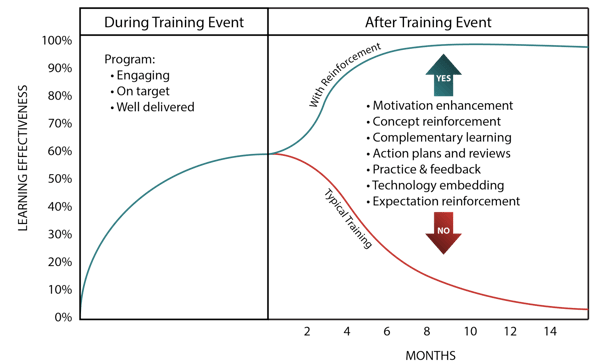I recently returned from an industry conference. The speakers were excellent and it was great to get away from my desk, connect with the attendees, and have the opportunity to step back and think big picture about what I need to be doing to drive success in my position. I returned with all sorts of notes, to-dos, and grand visions for change.
I was energized on my first day back in the office. Then the phone started to ring, the emails came flooding in, and my schedule filled with meetings. Two weeks later, while I had made some progress on my aspirational list of to-dos, by and large I was back to doing what I had always done.
The problem for me was that there was no support to make the change when I got back to the office.
The same thing happens after even the best sales training programs, especially if the training is structured as an instructor-led, event-based, one-time only affair. You can deliver the most engaging, relevant, and on-target sales training, but if there’s no support after the event, sellers go back to doing what they’ve always done and learning effectiveness lags. In Sales Training: The 120-Day Curse, ES Research found that between 85% and 90% of sales training has no lasting impact after 120 days.
Components of the Best Sales Training Programs
How do you make sure your sales training doesn’t fall victim to the 120-day curse? Structure training that attends to each of these components:
Align Desired Business Outcomes and Learning Needs
Before any training initiative you must have a clear understanding of a) the objectives and expectations of the business outcomes you seek and b) what skills, knowledge, and attributes your team needs to produce those outcomes in their sales roles.
[Checklist] How to Choose a Sales Training Provider >>
Build Sales Knowledge as Well as Skills
While most training focuses on building sales skills (which is an essential piece to the puzzle), they fail to focus on building sales knowledge (knowledge about your products and services, customer needs they fulfill, the marketplace and how your positioned, competition, etc.).
Assess Sales Teams
If you attend to point #1, you know what skills, knowledge and attributes are required for success. When you assess your team, you find the gaps that must be addressed during training. Knowing which metrics to assess puts you in the best position to monitor progress and skill retention.
Put a Sales Process and Sales Methodology in Place
The best sales training programs provide a process and methodology sellers can follow to move buyers through the pipeline. Without these you create a disconnect between training and on-the-job work flow.
Deliver Relevant and Engaging Learning
Training needs to be tailored for your company to address the types of sales situations your sellers face. Adults learn by doing, so the best sales training is highly interactive, including role-plays, exercises, and action learning.
Provide Ongoing Reinforcement and On-the-Job Support
Even after the best sales training programs, it’s too easy for sellers to go back to their desks and do what they’ve always done. Only through ongoing development, coaching, and learning will sellers make the behavior changes necessary for success.
Hold Sellers Accountable
Without accountability, sellers leave the classroom and think, “so what?” If there’s no incentive to change, and no one makes sure they are following through, they will revert back to doing what they’ve always done.
Do this and instead of learning being forgotten only months after training, effectiveness and results will look more like this:







